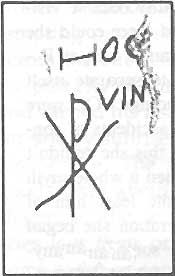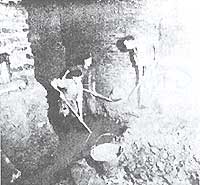|
Newsletter of the District
of Asia
January
- February 2000
The
Graffiti Wall
The bones of Saint Peter
By
J.E. Walsh
Second
Part
"
The first part of this article appeared in the Newsletter of September-
October 1999 January - February 2000"
As
Vatican II was coming to a close in 1965, so was the identificatino
of the Bones found underneath the Main Altar in St. Peter's, in
the Vatican. Providence was clearly indicating that it was truly
on St Peter that the Catholic Church was built and that real Catholic
apostolate had to bring souls into the roman Church, and not let
them live apar from it as is being done today with inculturation.
The mind behind the discovery of the actual bones of St Peter was
Dr. Guarducci.
 ER
REQUEST for permission to make a study of intriguing tangle was
quickly honored, but she was delayed for a while by some other commitments,
and by the writing of a report on the Valerius epigraph. It was.
September 1953 before she was able to begin. ER
REQUEST for permission to make a study of intriguing tangle was
quickly honored, but she was delayed for a while by some other commitments,
and by the writing of a report on the Valerius epigraph. It was.
September 1953 before she was able to begin.
 When
for the twentieth time her magnifying glass moved across the upper
left corner of the graffiti wall, there suddenly leaped out at her,
just above a Christ monogram, five letters arranged in two lines
As her first move at the graffiti Christ monogram, wall, Dr. Guarducci
arranged for a series of professional photographs to be taken of
the whole surface, overlapping close-ups which would capture every
nuance of the inscriptions. Spending hours each day at the wall,
usually kneeling on a cushion, one hand holding a light while the
other wielded the magnifying glass, she was soon oblivious to the
passing hours. As the days went by she fell into a steady rhythm.
Spending mornings at the basilica, then continuing her studies with
the photographs at home in the afternoons, the only break in the
routine coming from her teaching duties at the university. There
were also frequent visits to the libraries and museums of Rome as
she searched for any smallest light that might be thrown on the
scratches by the work of the other scholars in related fields. When
for the twentieth time her magnifying glass moved across the upper
left corner of the graffiti wall, there suddenly leaped out at her,
just above a Christ monogram, five letters arranged in two lines
As her first move at the graffiti Christ monogram, wall, Dr. Guarducci
arranged for a series of professional photographs to be taken of
the whole surface, overlapping close-ups which would capture every
nuance of the inscriptions. Spending hours each day at the wall,
usually kneeling on a cushion, one hand holding a light while the
other wielded the magnifying glass, she was soon oblivious to the
passing hours. As the days went by she fell into a steady rhythm.
Spending mornings at the basilica, then continuing her studies with
the photographs at home in the afternoons, the only break in the
routine coming from her teaching duties at the university. There
were also frequent visits to the libraries and museums of Rome as
she searched for any smallest light that might be thrown on the
scratches by the work of the other scholars in related fields.
 To
her great consternation, the first weeks of this intensive effort,
in which she tried one hypothesis after another while calling on
her while store of epigraphical knowledge, yielded exactly nothing.
Behind the enigmatic jumble she could discern no rationale, no pattern.
No ghost of a personality became visible. Only here and there could
she find some letter - an A, a B, an E - which appeared to separate
itself from its surroundings. Or were these forms mere accidents
of conjunction? Of even this she couldn't be certain, and when a
whole myth fled by without the least hint of progress, in desperation
she began casting around for something, anything, some stray bit
of information, that might afford even the slightest clue to the
wall's stubborn secret. To
her great consternation, the first weeks of this intensive effort,
in which she tried one hypothesis after another while calling on
her while store of epigraphical knowledge, yielded exactly nothing.
Behind the enigmatic jumble she could discern no rationale, no pattern.
No ghost of a personality became visible. Only here and there could
she find some letter - an A, a B, an E - which appeared to separate
itself from its surroundings. Or were these forms mere accidents
of conjunction? Of even this she couldn't be certain, and when a
whole myth fled by without the least hint of progress, in desperation
she began casting around for something, anything, some stray bit
of information, that might afford even the slightest clue to the
wall's stubborn secret.
 From
the strange embroidery on the graffiti wall, under Dr. Guarducci's
questing stare some fifty names eventually emerged, distinct and
separate, all of them familiar in third and fourth-century Roman
usage. About half were linked to a Christ monogram, and about a
third included prayers and invocations, always abbreviated, wishing
for the dead eternal joy in Christ. But even after isolating all
these names and phrases, often by minutely tracing out individual
letters in succession, there still remained the weird inundation
of extra lines from which no sense could be extracted. From
the strange embroidery on the graffiti wall, under Dr. Guarducci's
questing stare some fifty names eventually emerged, distinct and
separate, all of them familiar in third and fourth-century Roman
usage. About half were linked to a Christ monogram, and about a
third included prayers and invocations, always abbreviated, wishing
for the dead eternal joy in Christ. But even after isolating all
these names and phrases, often by minutely tracing out individual
letters in succession, there still remained the weird inundation
of extra lines from which no sense could be extracted.
 Further
weeks of fruitless study passed, then months, and despite the many
fatiguing hours she spent on her knees before the wall, or bent
over the pile of photographs at home, her bafflement continued to
deepen. Earnest discussion of the vexing problem with her sister,
with colleagues at the university, and with Pope Pius himself, brought
sympathy and encouragement but no real assistance. Once during those
months, however, her efforts were rewarded with a discovery and
though it proved of no assistance in deciphering the other scratches,
in its own way it was electrifying. Further
weeks of fruitless study passed, then months, and despite the many
fatiguing hours she spent on her knees before the wall, or bent
over the pile of photographs at home, her bafflement continued to
deepen. Earnest discussion of the vexing problem with her sister,
with colleagues at the university, and with Pope Pius himself, brought
sympathy and encouragement but no real assistance. Once during those
months, however, her efforts were rewarded with a discovery and
though it proved of no assistance in deciphering the other scratches,
in its own way it was electrifying.
 |
|
Fig.
1
|
 When
for the twentieth time her magnifying glass moved across the upper
left corner of the graffiti wall, there suddenly leaped out at her,
just above a Christ monogram, five letters arranged in two lines
(see Fig. 1): When
for the twentieth time her magnifying glass moved across the upper
left corner of the graffiti wall, there suddenly leaped out at her,
just above a Christ monogram, five letters arranged in two lines
(see Fig. 1):
 At
their right edges both lines ran into broken plaster and could thus
have once been longer. In fact, the ragged form of what might have
been a C still clung vaguely to the end of the first line. Instantly
Dr. Guarducci recognized the phrase for what it was, the only thing
it could be: IN HOC VINCE, Latin for "In this, conquer."These
very words, she knew, had formed part of Constantine's famous aerial
vision in the year 312, just before his final battle for home. In
the vision, the words had been accompanied by some unspecified type
of cross, and the Emperor had jubilantly ordered his troops to paint
the emblem on their shields and helmets. A rapid victory had followed. At
their right edges both lines ran into broken plaster and could thus
have once been longer. In fact, the ragged form of what might have
been a C still clung vaguely to the end of the first line. Instantly
Dr. Guarducci recognized the phrase for what it was, the only thing
it could be: IN HOC VINCE, Latin for "In this, conquer."These
very words, she knew, had formed part of Constantine's famous aerial
vision in the year 312, just before his final battle for home. In
the vision, the words had been accompanied by some unspecified type
of cross, and the Emperor had jubilantly ordered his troops to paint
the emblem on their shields and helmets. A rapid victory had followed.
 |
|
The
excavations beneath St. Peter's
|
 As
it happened, the earliest report of this memorable incident was
a contemporary one, written down from Constantine's own lips by
the historian Eusebius. In his short account, and almost as an afterthought,
Eusebius had also preserved the vital fact that the Emperor had
not been the only witness to the arresting sight: "He said that
with his own eyes, during the afternoon, while the day was already
fading, he had seen a shining cross in the sky, more brilliant than
the sun, accompanied by the words, `In this, conquer.' He remained
stunned by the vision, and so did all the army following him in
the expedition, which had also seen the miracle:" As
it happened, the earliest report of this memorable incident was
a contemporary one, written down from Constantine's own lips by
the historian Eusebius. In his short account, and almost as an afterthought,
Eusebius had also preserved the vital fact that the Emperor had
not been the only witness to the arresting sight: "He said that
with his own eyes, during the afternoon, while the day was already
fading, he had seen a shining cross in the sky, more brilliant than
the sun, accompanied by the words, `In this, conquer.' He remained
stunned by the vision, and so did all the army following him in
the expedition, which had also seen the miracle:"
 The
marvel had quickly become an accepted part of church history and
had remained so, unquestioned, for many centuries. More recently
there had arisen a tendency among scholars to question its factual
basis. The
marvel had quickly become an accepted part of church history and
had remained so, unquestioned, for many centuries. More recently
there had arisen a tendency among scholars to question its factual
basis.
(to
be continued)
|


![]()
![]()

